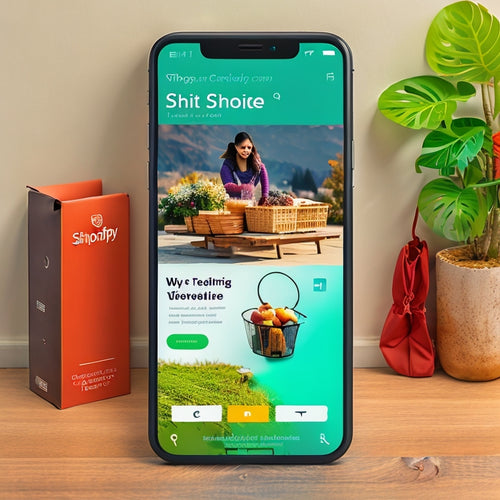
Course Creation Strategies for Online Growth
Share
You're struggling to make your online course stand out in a crowded market. To break through, you need a solid strategy. Start by pinpointing your target audience and understanding their unique challenges and goals. Craft engaging content that resonates with them, and choose a platform that aligns with your goals. Develop a pricing strategy that reflects the value you provide, and build a sales funnel that drives conversions. Leverage email marketing to nurture leads, and track key metrics to measure course effectiveness. By implementing these strategies, you'll be well on your way to online growth - and that's just the beginning of your journey to success.
Key Takeaways
• Identify your target audience through market research, surveys, and feedback to create resonating course content that addresses their unique challenges and goals.
• Develop a clear and compelling course content strategy that aligns with your students' objectives, tracks engagement, and measures success.
• Select a platform that aligns with your course goals, customize it for brand consistency, and utilize user analytics to drive data-driven decisions.
• Implement dynamic pricing, promotions, and sales strategies that consider the value provided, competitive analysis, and customer retention to drive sales and revenue.
• Continuously measure course effectiveness, collect feedback, and refine course content to improve student outcomes, engagement, and overall course success.
Identifying Your Target Audience
Pinpointing your target audience is essential to creating a course that resonates with them, so take the time to dig deep and uncover their needs, pain points, and motivations.
You can't create a course that meets everyone's needs, but you can create one that speaks directly to a specific group. That's where market research comes in. Conduct surveys, gather feedback, and analyze industry trends to get a clear picture of who your ideal student is. This will help you identify patterns and create audience segments.
For instance, if you're creating a course on marketing, your segments might include small business owners, entrepreneurs, and marketing professionals. By understanding the unique challenges and goals of each segment, you can tailor your course content to meet their specific needs.
Crafting Engaging Course Content
Now that you've identified your target audience, it's time to craft course content that resonates with them.
You'll want to pinpoint the core learning objectives that will drive student success, and then determine how to present that information in a compelling way.
Core Learning Objectives
To craft engaging course content, you need to identify the core learning objectives that align with your students' needs and goals, ensuring they stay motivated and focused throughout the learning journey. These objectives serve as a roadmap, guiding you to create content that resonates with your students and helps them achieve their desired outcomes.
By setting clear objectives, you'll be able to measure success and track student engagement, making adjustments as needed to optimize the learning experience.
When defining your core learning objectives, ask yourself:
- What do I want my students to take away from this course?
- What skills or knowledge do I want them to acquire?
- What changes do I want them to make in their lives or careers?
Be specific, concise, and measurable in your objectives, and make sure they're aligned with your students' goals and aspirations. By doing so, you'll create a sense of purpose and direction, leading to higher student engagement and a more effective learning experience.
Compelling Storytelling Techniques
As you craft your course content, harness the power of storytelling to capture your students' attention and make complex concepts more relatable and memorable. Storytelling is an effective way to convey information, evoke emotions, and create a lasting impact. To craft compelling stories, focus on visual storytelling, which combines images, videos, and graphics to convey your message. This approach helps students connect emotionally with the content, making it more engaging and memorable.
| Technique | Description |
|---|---|
| Character Development | Introduce relatable characters that students can empathize with, making the story more engaging and personal. |
| Narrative Arc | Create a clear structure with a beginning, middle, and end, building tension and resolving conflicts. |
| Emotional Connection | Use storytelling to evoke emotions, creating a deeper connection with the students and making the content more memorable. |
| Visual Storytelling | Combine images, videos, and graphics to convey complex information in an engaging and easy-to-understand format. |
| Authenticity | Share personal anecdotes and experiences, making the story more relatable and authentic. |
Choosing the Right Platform
When it comes to choosing the right platform for your online course, you're spoiled for choice - but that's exactly what makes it so overwhelming.
You need a platform that aligns with your goals, is easy to navigate, and offers the features you need to create an engaging learning experience.
As you weigh your options, remember that the platform's features and ease of use will directly impact your ability to create a high-quality course that resonates with your students.
Platform Features Matter
You're likely to find that the features of your chosen platform have a significant impact on the overall success of your online course. The right features can help you create a seamless learning experience, while the wrong ones can lead to frustration and disappointment.
When selecting a platform, it's crucial to examine the customization options available. Can you adjust the platform to match your brand's unique style and voice? Are you able to create a consistent look and feel throughout your course?
Additionally, user analytics are vital for understanding how your students are engaging with your content. Can you track their progress, identify areas of struggle, and make data-driven decisions to improve your course? Look for a platform that provides detailed analytics and insights to help you refine your teaching strategy.
Ease of Use Counts
Ease of Use Counts
Selecting a platform that's intuitive and easy to navigate is essential, since it directly impacts the time and effort you'll devote to creating and delivering your online course. You'll want to choose a platform that's designed with user experience in mind, incorporating design principles that make it easy for you to focus on creating high-quality content.
Here's a breakdown of what to look for in a platform:
| Feature | Why it Matters | Example |
|---|---|---|
| Intuitive Interface | Reduces time spent on setup and maintenance | Drag-and-drop course builder |
| Customizable Templates | Allows for branding consistency and ease of use | Pre-built templates for course pages |
| User-Friendly Analytics | Helps you track student progress and make data-driven decisions | Visual dashboards for course performance |
Pricing Strategies for Success
Determining the best price for your online course can make all the difference between attracting a flood of students or struggling to fill seats. You've put in the effort to create a high-quality course, and now it's time to price it right.
One effective strategy is dynamic pricing, where you adjust your price based on demand. For instance, you can offer early bird discounts or limited-time promotions to drive sales. Another approach is to conduct a competitive analysis to see what similar courses are charging. This will give you a baseline to work from and help you position your course competitively.
When setting your price, consider the value your course provides to students. If your course offers unique insights, exclusive content, or personalized support, you may be able to charge a premium. On the other hand, if your course is more introductory or covers basic material, you may need to price it more competitively.
Building a Sales Funnel
Now that you've set a price for your online course, it's time to think about how you'll guide potential students through the buying process, and a well-structured sales funnel is key to making that happen.
A sales funnel is a series of steps designed to convert leads into paying customers. To build an effective funnel, you need to focus on lead generation, conversion optimization, and customer retention.
Start by creating a compelling sales pitch that resonates with your target audience. This will help you attract high-quality leads and increase the chances of converting them into customers.
Once you've got their attention, make sure your funnel is optimized to guide them through the buying process seamlessly. This means removing any obstacles, reducing friction, and providing a clear call-to-action at each stage.
Leveraging Email Marketing
With your sales funnel in place, your next step is to harness the power of email marketing to nurture leads, build trust, and ultimately drive sales of your online course.
You'll want to create targeted email campaigns that speak directly to your audience's pain points and interests. To do this, try segmenting your email list based on demographics, behavior, or engagement. This will allow you to tailor your messaging and increase its effectiveness.
Next, use A/B testing to refine your email strategy and identify what resonates with your audience. Test subject lines, CTAs, and even the tone of your emails to see what drives the best results.
Once you've got a winning formula, use automation to streamline your email workflow and save time. But don't sacrifice personalization for efficiency - use tools like email automation software to add a personal touch to your messages.
Measuring Course Effectiveness
As you roll out your online course, you're probably excited to know whether it's hitting the mark, and that's where measuring its effectiveness comes in. You want to know if your students are engaged, if they're learning, and if they're achieving their goals.
To do this, you need to track key metrics that reveal the impact of your course. Start by analyzing student engagement metrics, such as completion rates, time spent on lessons, and quiz scores. This will give you a sense of how invested your students are in the course material.
Next, conduct feedback analysis to understand what's working and what's not. Collect feedback through surveys, discussion forums, or one-on-one interviews to identify areas for improvement. By tracking these metrics, you'll be able to refine your course content, improve student outcomes, and ultimately, increase the effectiveness of your online course.
Frequently Asked Questions
Can I Sell My Course on Multiple Platforms at Once?
'Go ahead, be a rebel, sell your course on multiple platforms at once! You'll increase your revenue potential and marketing reach, but guarantee platform compatibility and consider how to maintain audience engagement across each site.'
How Long Does It Take to Create a Successful Online Course?
You're wondering how long it takes to create a successful online course. Honestly, it depends on your time management skills during course development and how well you conduct market research to inform your course promotion strategy.
Do I Need to Be an Expert to Create a Successful Course?
'You're not a master chef, but you can still whip up a mean dish. Similarly, you don't need to be an expert to create a successful course, but having some expertise level helps. Focus on high course quality and marketability to guarantee success.'
Can I Update My Course After It's Already Been Published?
You can definitely update your course after it's published! You'll want to incorporate feedback, refresh content, and boost student engagement to guarantee continuous course improvement - it's an ongoing process that'll keep your students coming back for more!
What if I Don't Have Any Testimonials for My Course?
"Are you worried that your lack of testimonials will tank your sales? Don't sweat it! You can build credibility by leveraging case studies or offering a free trial to get that social proof you need."
Related Posts
-

Which Free App Is Used for Social Proof on The Shopify Store
This article explores the use of a free app for social proof on the Shopify store. It analyzes the benefits of emplo...
-

5 Best Ways to Scale Ecommerce With Online Courses
You're already crushing it in ecommerce, but you want to take it to the next level. You can do just that by leveragin...
-

Customer Shopify Apps Focus on Enhancing the Customer Experience and Fostering Loyalty
This article explores the role of customer Shopify apps in enhancing the customer experience and fostering loyalty. ...


